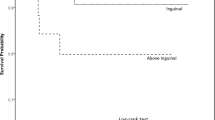Abstract
A review of 468 orchidopexies was undertaken to ascertain the importance of a complete hernial sac extending to or beyond the testis. A hernial sac was present in 84% (171/202) of testes in patients under 5 years of age, in contrast to 23% (61/266) in patients over 5 years. It seems reasonable to presume that the failure of the hernial sac to close is secondary to failure of normal descent, which in turn is due to antenatal factors and may be classified as “early maldescent”. In the older age group maldescent is due to failure of the last stage of descent, which should occur in the 5- to 10-year prepubertal age period (“late maldescent”, or the “ascending” testis). The cause of late maldescent is not due to a short processus, as this increases in length with age (approximately 0.5 cm/year), unless the persistence of the processus itself is the cause. A classification of early or late maldescent is suggested.
Similar content being viewed by others
References
Chilvers C, Pike MC, Forman D, Fogelman K, Wadsworth MEJ (1984) Apparent doubling of frequency of undescended testes in England and Wales in 1962. Lancet II, 81: 330–332
Davey RB (1997) Undescended testis: the relative importance of each step of mobilisation. Ped Surg Int 12: 163–164
Fenton EJM, Woodward AA, Hudson IL, Marschner I (1990) The ascending testes. Pediatr Surg Int 5: 6–9
Hadziselimovic F (1977) Cryptorchidism; ultrastructure of normal and cryptorchid testis development. Adv Anat Embryol Cell Biol 53: 3
Hedinger CE (1982) Histophatology of undescended testes. Eur J Pediatr 139: 266–271
Hutson JM, Williams MPL, Attah A, Larkins S, Fallat ME (1990) Undescended testes remain a dilemma despite recent advances in research. Aust N Z J Surg 60: 429–439
MacKellar A (1988) Undescended testes: how history and examination may influence treatment. Aust N Z J Surg 58: 643–645
Myers NA, Officer CB (1975) Undescended testes: congenital or acquired? Aust Paediatr J 11: 76–80
Scorer CG (1964) The descent of the testis. Arch Dis Child 39: 605
Williams MPL, Hutson JM (1991) The history of ideas about testicular descent. Pediatr Surg Int 6: 180–184
Wyllie GG (1984) The retractile testes. Med J Aust 140: 403–405
Author information
Authors and Affiliations
Rights and permissions
About this article
Cite this article
Davey, R.B. Undescended testes: early versus late maldescent. Pediatr Surg Int 12, 165–167 (1997). https://doi.org/10.1007/BF01349990
Accepted:
Issue Date:
DOI: https://doi.org/10.1007/BF01349990




